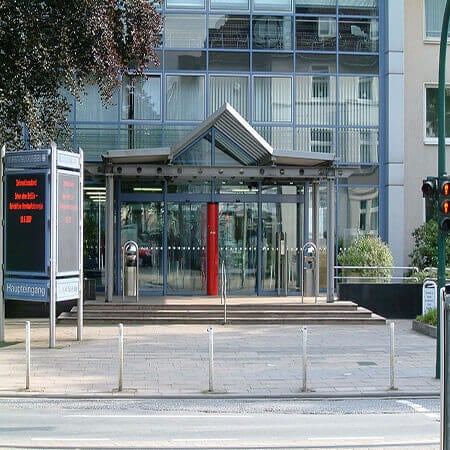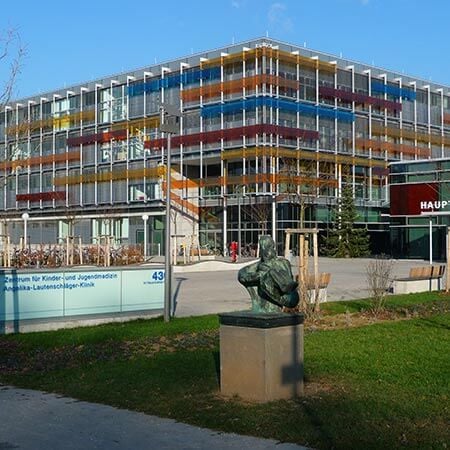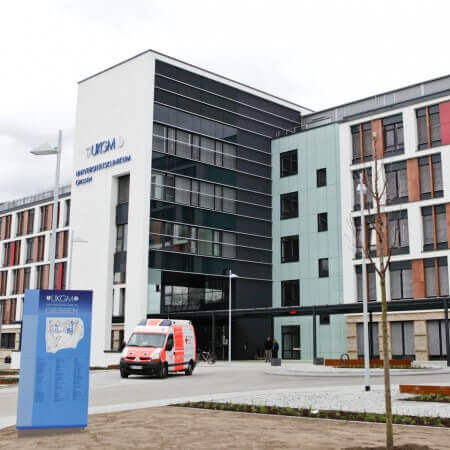Breast Cancer — Proton Therapy: treatment in the Best Hospitals in the World
Treatment prices are regulated by national law of the corresponding countries, but can also include additional hospital coefficients. In order to receive the individual cost calculation, please send us the request and medical records.
Breast Cancer Treatment
- Diagnostics
- Reconstruction with an expander or allo prosthesis
- Diep-flap plastic reconstruction with own tissues
- Reconstruction with own tissue or implant after radical mastectomy
- Radical mastectomy
- Brachytherapy
- Chemotherapy
- Lumpectomy and lymphadenectomy by metastases to lymph nodes
- Radiotherapy
- Sectoral resection with flap plastic
- Embolization or chemoembolization

Department of Adult and Pediatric Proton Therapy
The Department of Adult and Pediatric Proton Therapy offers the full range of proton treatment and it is one of the leading and most progressive medical facilities of this kind not only in Germany, but throughout the world. The proton therapy is mostly used for the treatment of tumors of the eye, brain, spine and pelvic organs. Also, the proton therapy is an excellent treatment of tumors in children, since it has a minimal negative effect on the immature, sensitive tissues of the child’s body.







National Center for Tumor Diseases (NCT) Heidelberg
The National Center for Tumor Diseases (NCT) Heidelberg offers the full range of diagnostics and treatment of various oncological diseases. Since its foundation in 2004, the center has gained a reputation of one of the leading in Germany. The center is supported by the German Cancer Research Center (DKFZ) and the German Cancer Aid (Deutschen Krebshilfe). The center treats about 60,000 patients from 45 countries every year. Thanks to the outstanding research activities, the department has the very latest therapeutic opportunities that save lives for thousands of people.


Proton Therapy Center
The Proton Therapy Center specializes in an innovative type of radiation therapy for children, namely proton therapy. The medical facility is one of four centers in Germany offering proton therapy for cancer treatment in young patients. The center has been working since October 2015 in close cooperation with the Marburg Ion Beam Therapy Center and today can boast exceptional clinical experience in the field of its competence. Proton therapy is significantly superior to conventional radiation therapy in terms of dose control, dose distribution and side effect profile. Thus, it is an excellent alternative form of cancer treatment. The main advantage of proton therapy is that it has potentially fewer immediate and long-term side effects as compared to classical radiation therapy. The harmful effects on healthy tissues during proton therapy are minimized, which is especially important for children, as their brain and body are in the growth phase. In addition, proton therapy is provided on an outpatient basis and is an absolutely painless treatment, which is also important for young patients.

Breast cancer is the most common oncopathology in women. It can be successfully treated if detected early. Nevertheless, for European doctors it is important not only to cure the disease, but it is also necessary to do this in such a way as to avoid serious complications from the vital organs and to ensure a high quality of life for a woman after defeating cancer. In developed countries, medical specialists use proton therapy, which is a more sparing and a safe radiation option for health compared to conventional photon radiation therapy. Its main advantages are lower risk of radiation damage to the heart, lower risk of myocardial infarction in the long-term period, less radiation exposure to the lungs and higher quality of life for women after cancer treatment.
Content
- Breast cancer treatment principles
- What is proton therapy
- Health safety evidence
- Who should undergo proton therapy for breast cancer
- Is proton therapy more effective
- Impact on quality of life
- Why is it worth undergoing treatment abroad
- Treatment in Europe with Booking Health at an affordable price
Breast cancer treatment principles
Radiation therapy is one of the most important treatment methods for breast cancer, along with surgery and chemotherapy. It is most often used after breast-conserving surgery. Less commonly, radiation exposure is used:
- After mastectomy (total breast removal).
- Before surgery to remove the breast (neoadjuvant therapy) in order to reduce the size of the tumor.
- In the advanced stage of the disease, to control pathology and increase life expectancy – doctors irradiate both the primary tumor and its metastases with radiation.
Breast cancer is considered curable up to stage 3. Moreover, it is usually detected earlier, namely at stage 0, 1 or 2. Most countries offer special screening programs based on an annual mammography. The diagnostic test allows tumors to be detected before they cause any symptoms or become palpable.
In the early stages, preference is given to organ-preserving interventions. They provide better aesthetic results and are safer for health. However, patients after such operations need radiation therapy, which can be carried out using both photons and protons. Less often, mainly with large tumors, doctors resort to mastectomy, which implies total breast removal. After this surgical intervention, radiation therapy is performed only if indicated. Nonetheless, if it is needed, it causes more side effects and complications as compared to women after breast-conserving surgery. Therefore, those patients who had mastectomy are considered prime candidates for proton therapy, which is more sparing for health.
What is proton therapy
Radiation exposure for breast cancer is very effective. It allowed doctors to perform breast-conserving surgery instead of total breast removal, which used to be the standard treatment in the 20th century. However, radiation therapy carries certain health risks. They are due to the fact that radiation inevitably penetrates the heart and lungs. The risk of side effects and complications from radiation exposure to the left breast is especially high. It is also high in women with a tumor located in the lower left square of the right breast.
Malignant tumors usually are irradiated with photons. Doctors use linear accelerators that deliver radiation to cancer cells very accurately. The rays enter the body from different sides and converge on the tumor. As a result, the dose of radiation for the tissues of the neoplasm is maximum possible, and for healthy tissues it is relatively low.
But still, a feature of photons is the scattering of radiation along the entire trajectory of the rays. Protons are devoid of this disadvantage. They release most of the energy only when they reach the target, that is, inside the tumor, but not on the way to it.
Proton therapy was first used in the United States in the middle of the 20th century. It gained significant popularity in the 80s. It was used mainly for intracranial tumors. Since the 90s, doctors have begun to use proton therapy for the treatment of neoplasms of a wide variety of organs, including those located in the chest, pelvis, and abdominal cavity.
Numerous studies have shown that proton therapy is safer for health even with the latest types of photon irradiation, including stereotactic body radiation therapy (SBRT), volumetric modulated arc therapy (VMAT), and intensity-modulated radiation therapy (IMRT).
Proton therapy is not used so often in medicine because of its high price and low availability, as not every country has specialized proton centers. But it is gradually gaining popularity. There are already dozens of proton therapy centers operating in the world, and more than 150 thousand people have been treated with this type of irradiation.
Health safety evidence
The key advantage of protons is safety for the health of patients. It has been repeatedly confirmed in clinical and dosimetric studies.
The largest study comparing proton therapy for breast cancer with other radiation treatment options was conducted in the United States. The authors used the National Cancer Database to test if protons have clinical benefits. The researchers used data from 724,492 patients. Only 871 of them received proton therapy. In the rest, breast cancer was treated with other radiation methods.
Patient survival rates were comparable. In the proton group, the five-year survival rate has reached almost 92%, and in the photon group it was only 89%. A difference of 2% is not considered statistically significant.
But there is no doubt about the safety of the method for health. The authors concluded that the radiation doses to the heart and lungs were lower. Due to the short follow-up period, they were unable to find out how much the risk of complications in the long-term period decreases. However, the potential benefit can be calculated using a mathematical model, since earlier studies have already determined that the higher the radiation exposure to the heart, the more often coronary events (myocardial infarction) occur in patients.
For example, a study by Darby et al. showed an increased risk of coronary events after radiation therapy. The likelihood of heart complications increased by 7.4% for every 1 Gy of radiation.
Kozak's study showed a 10-fold decrease in the average dose of radiation to the heart when using protons after mastectomy. It was from 2.0 to 0.2 Gy.
Similar results have been demonstrated in other studies. For left-sided breast cancer in Bradley's study, the radiation dose to the heart was reduced by a factor of 10, from 5.9 to 0.6 Gy, compared with photon radiation therapy. In right-sided tumors, protons were also safer, although the difference was smaller: the radiation dose decreased from 2.9 to 0.5 Gy.
Thus, for patients from risk groups, the use of protons instead of photons means a reduction in the risk of severe cardiovascular diseases by 20-30% or more.
Who should undergo proton therapy for breast cancer
Photon therapy has been successfully used for breast cancer in most patients. It is cheaper but produces comparable results.
However, research shows that certain categories of patients may benefit from the use of protons. First of all, proton therapy is indicated for those who are expected to have an increased radiation load on the heart. These are four categories of patients:
- Tumors of the left mammary gland.
- Neoplasms of the left lower quadrant of the right mammary gland.
- Patients after mastectomy (total breast removal).
- Women after breast-conserving operations, in which not only the rest of the breast is irradiated, but also the lymph nodes (irradiation of the internal lymph nodes of the mammary gland is especially dangerous for the heart).
Proton therapy for breast cancer treatment can be used not only in the advanced, but also in the early stages of the disease. Data from the US National Cancer Database show that 58% of women received proton irradiation after breast-conserving surgery performed for stages 0 and 1. Another 42% were diagnosed with breast cancer stage 2 or 3.
Proton therapy may be worthwhile for patients with Her2 positive breast cancer. Typically, women with this subtype of breast cancer receive targeted therapy with drugs that are toxic to the heart. The combination of drug treatment and radiation therapy further increases the risk of cardiovascular complications. The use of protons instead of photons reduces these risks.
Is proton therapy more effective
In breast cancer, proton therapy is not more effective than photon radiation, but it can still improve the long-term overall survival of patients.
There is no contradiction in this. Patients with breast cancer die not only from the oncology itself, but also from the consequences of its treatment. One of the possible long-term consequences is myocardial infarction, associated with damage to the heart and coronary vessels by radiation. Another consequence is the development of such secondary tumors as angiosarcoma. They are associated with the effects of radiation on healthy breast tissues. These tumors are very aggressive and can rarely be cured.
In addition, proton therapy may be more effective in some patients. When using photon radiation, doctors are forced to find a compromise between achieving a good oncological result and the safety of therapy for health. Sometimes photons cannot deliver the entire dose of radiation to the tumor without damaging vital organs. In such cases, it is necessary to reduce the dose of radiation, which can lead to an increased risk of breast cancer recurrence. If protons are used, doctors can deliver the full dose of radiation without damaging the surrounding tissues, thus achieving the best possible results in treating the disease.
Impact on quality of life
When treating cancer, it is worth considering not only life expectancy, but also its quality. It depends on the physical and emotional state of the woman. Both her well-being and the appearance of her breast are important.
Sandra L. Teichman et al. conducted a study with the participation of 129 women who received proton therapy after surgery. At the time of treatment, they were diagnosed with stage 0, 1 or 2 breast cancer. The authors concluded that the quality of life of these women is higher than that of those who received standard radiation therapy.
Irradiation can impair the aesthetic results of breast plastic surgery, which is performed immediately when the tumor is removed. Protons damage healthy tissues near the target less, and therefore improve the cosmetic effect. More than 90% of women from among the subjects stated high satisfaction with the aesthetic result. Other advantages derived from this study are as follows:
- Less pain.
- Less fatigue
- Lower level of restrictions in daily activities.
The possibility of using protons instead of photons may be an argument in favor of breast-conserving surgery for some women. One of the indications for mastectomy is the presence of diseases that make radiation exposure unsafe for health.
Despite the attractiveness of organ-preserving interventions, the disadvantage is the need for postoperative radiation therapy to reduce the risk of recurrence.
Protons are a safer source of radiation for health than photons. Therefore, irradiation by this method can be used even by women in whom the use of conventional radiation therapy is undesirable due to the high risk of complications. Thus, proton irradiation makes it possible to remove only part of the breast for women who would otherwise have to remove the entire breast.
Why is it worth undergoing treatment abroad
Doctors in countries with developed medicine use special techniques to minimize radiation exposure to the heart and other organs. These are as follows:
- Deep inspiration breath hold.
- Irradiation in the prone position.
- Protection of the heart with cardiac event recorders, drugs.
- Modulation of radiation intensity.
Intensity modulation has become possible not only for photons, but also for protons. The new active scanning technology makes it possible to irradiate the tumor in layers, changing the radiation dose for different areas. The introduction of this method has led to an additional increase in the safety of proton therapy.
There are several reasons for you to undergo proton therapy for breast cancer abroad:
- Extensive experience in the use of protons in breast cancer.
- Availability of the latest technologies, including active pencil beam scanning, as a result of which proton therapy becomes even safer.
- Use of additional methods of protecting the heart in patients with a high risk of heart lesions.
- Low prices – much lower than in the USA and Japan.
- Advanced equipment: many proton therapy centers in Europe have been opened recently, and therefore they use the latest technologies.
- Successful combination of radiation with other breast cancer treatment options: surgery, targeted therapy, hormone therapy, immunotherapy, chemotherapy, embolization, etc.
Treatment in Europe with Booking Health at an affordable price
To undergo proton therapy for breast cancer in one of the European hospitals, please use the services of the Booking Health company. On our website, you can find out the cost of treatment in different clinics, compare prices and book a medical care program at a favorable price. The cost of breast cancer treatment with proton therapy in different German hospitals ranges from 83,000 EUR to 87,000 EUR. Proton therapy will be easier and faster for you, and the cost of treatment will be lower due to the exclusion of extra fees.
Please leave your request on the Booking Health website. Our employee will contact you and advise you about treatment in Europe. Booking Health will take care of the organization of your trip. We will provide the following benefits for you:
- We will select a hospital for treatment in Europe that uses proton therapy to irradiate patients with breast cancer.
- We will help you overcome the language barrier, establish communication with your attending physician.
- We will reduce the waiting time for the start of the medical care program and book a doctor's appointment on the most suitable dates.
- We will reduce the price. The cost of treatment in European hospitals will lower due to the lack of additional coefficients for foreign patients.
- We will take care of all organizational issues: documents for entering the country, transfer from the airport, hotel, interpreting services, etc.
- We will prepare a program and translate medical documents. You do not have to repeat the previously performed diagnostic procedures.
- We will provide communication with the hospital after the completion of treatment in Europe.
- We will organize additional diagnostic examinations and treatment in a European hospital, if necessary.
- We will buy medicines abroad and forward them to your native country.
- We will help you keep in touch with the hospital and the doctor after the completion of treatment in Europe.
You will receive treatment from the best doctors in the world. The Booking Health staff will help reduce the cost of treatment and take care of all organizational issues, and you will only have to focus on restoring your health.
Authors: Dr. Nadezhda Ivanisova, Dr. Sergey Pashchenko

